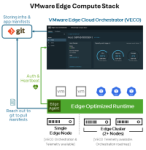As the number of remote workers surges, challenges facing enterprise security architectures follow — from protecting vast volumes of company data to safeguarding users’ personal devices.
Consequently, 90% of IT teams are rethinking their network strategy and revamping it with cloud-based VMware SASE™. Combining VMware SD-WAN™ with secure service edge (SSE) security, SASE boosts your network’s performance while guarding everything inside it like a vault.
Today, on their journey to SASE, teams may take two different paths. They might try to consolidate their web edge services and their security services simultaneously with a single vendor to achieve a SASE architecture.
Or, they may already have pieces of a SASE solution and seek to acquire the remaining pieces from other SD-WAN or security vendors.
What are the challenges with both approaches? By consolidating all at once, teams risk selecting a vendor who specializes in security but not SD-WAN, creating an incomplete SASE solution. And if teams mix and match their solution — maybe keeping their security service but changing their SD-WAN provider — can SASE actually be achieved?
A lot to consider, right? No worries, a solution is coming soon. Harnessing the power of a fully converged SASE solution changes the game — empowering you to partner with one vendor instead of managing many. This will create a one-stop-shop customer experience that’s consolidated, simplified, and affordable — slashing your team’s workload.
Let’s explore a few ways a converged VMware SASE solution will help…
1. Reduced operational complexity
Using a multi-vendor solution, you’re piecemealing many components together, which convolutes your integration process and increases the chance for human error. For example:
- Multiple feature templates must be attached to numerous devices
- API keys must be generated to associate with external services
- New policies must be defined
- SD-WAN tunnels must be mapped to the policies
- Policies must be configured across multiple solutions
Who has time to manage all of that?
With a true single-vendor solution, after defining your policy, you can deploy it across your network edges — to a few sites or thousands— in minutes. This lies in stark contrast to a multi-vendor solution, which stretches that process to days.
So, when considering operational complexity, you don’t need a magic crystal ball to understand how you’ll set up your network in the future. If one vendor’s capability rivals multiple vendors’ best of breeds and delivers simplified operations, you’ll jettison your multi-vendor solution, because you will never fully unify your platforms and they will always be operationally complex.
2. Decreased TCO
Operational costs aren’t something you can easily quantify, but you need a risk model in place to understand that you may experience an outage eventually.
For example, recently, an individual contributor in an organization went rogue and opted to make some significant firewall changes — during business hours. This pushed down a rule set to dozens of firewalls that caused their company to become completely isolated from the Internet as their firewalls were widely distributed to dozens of sites, making it tough for their IT team to readily access. This led to four hours of lost business and outages across thousands of sites. This may sound familiar to you — Facebook experienced a similar outage.
If that organization used a converged, cloud-delivered, VMware SASE-based solution, they wouldn’t have been isolated from the management capabilities of that solution. While a handful of end users might have been impacted, the IT team could have easily resolved the issue.
With a converged solution, a low TCO is an easy target to hit because everything is cloud-hosted. You don’t need to set it up, maintain it, or patch it. And by using a single pane of glass, it’s cheaper and easier to operate.
Diving deeper, Forrester’s 2022 Total Economic Impact study revealed that a single pane of glass helped companies extract significant operational benefits by managing their networking and security infrastructure. This eliminated the burden of designing, deploying, and troubleshooting the lifecycle of on-premises solutions.
3. Full bandwidth utilization
Most SASE vendors rely very heavily on legacy connectivity methods that restrict bandwidth.
As network traffic continues to grow, the need for higher bandwidth will continue to outpace what’s possible with legacy solutions. Instead, many enterprises opt for broadband circuits, bolstering their reliability with SD-WAN. This empowers IT teams to either replace or augment their legacy circuits without being gated by lower bandwidth legacy circuits.
For example, some businesses are ditching their MPLS for SD-WAN because MPLS is cost-prohibitive and they don’t get a lot of throughput for their ROI.
What kind of solution should you seek? Check out VMware SD-WAN, which provides secure and reliable connectivity from anywhere and across transport methods like MPLS, cable, DSL, LTE, or even satellite links when necessary.
Further, VMware SD-WAN offers Dynamic Multipath Optimization™ (DMPO) that helps you exploit all the available bandwidth across your multiple links.
But what if you don’t use dual links? If you’re using broadband connectivity for just a single link, there’s no guarantee the link will remain healthy. Leveraging DMPO helps there too.
For example, let’s say your service provider provides you with one terabyte of connectivity. This doesn’t mean you’re consistently guaranteed one terabyte. Sometimes WAN conditions deteriorate, where you only receive 800 – 900 Mbps. And when the bandwidth drops, so do the packets. But through DMPO, packets can be replicated, which reduces the probability of packet loss by 50% so you avoid poor connectivity conditions.
From simplifying operations to slashing TCO to boosting bandwidth, a converged VMware SASE solution offers countless benefits — and it’s right around the corner. By converging your SASE services with a single vendor, you’ll take your network management to the next level — empowering your company to concentrate more on expanding its business and spend less time on managing network logistics.
Learn More
- Visit the VMware SASE website and check out webinars, white papers, case studies, and much more.
- Want a closer look at VMware SD-WAN? Read the solution overview.







